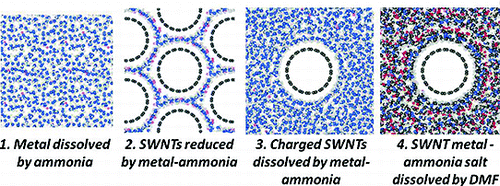January 19, 2012 report
British team devises method for separating carbon nanotubes cheaply

(PhysOrg.com) -- When single walled carbon nanotubes (SWCNTs) are made, they come out in both metallic and semiconducting material form. Unfortunately, different applications require one or the other of these materials, but not both, which means they need to be separated. Even more unfortunately, efforts to do so have proven to be very expensive. Now, though, due to the efforts of a British team of physicists, as they describe in their paper in ACS Nano, a new method has been devised that allows SWCNTs to be separated cheaply enough to allow for bulk manufacturing.
It was only recently that a team at Stanford University devised a means for separating and sorting the two distinct forms of the SWCNTs, a breakthrough that had researchers dreaming of such exotic applications as artificial skin. Sadly though, the process they devised would have cost billions to produce just a kilo of the stuff, which of course very quickly put a damper on the development of applications.
Now though, the team in Britain from London’s Imperial College, led by Milo Shaffer, has figured out a way to do the job cheaply, and it’s all due to researchers from another lab at University College, discovering that Buckminster fullerenes dissolve in ammonia. To develop the new process, teams from both labs worked together.
The new process works like this. First the nanotubes are dissolved in a sodium and ammonia solution to purify and pull them apart, creating what they call a “nanotubide” solution; afterwards, the ammonia is removed. The result is a salt and nanotubide dry powder. The team then adds dimethylformamide to the powder which causes a portion of the salt-laden nanotubide to dissolve. By using just the right concentration in the original solution, the team has found that they can retrieve material that is mostly metallic SWCNT from the dissolved salt. And that, in all its simplicity, is pretty much all there is to it.
Besides allowing for SWCNTs to be made cheaply, the new process also eliminate the need for using a centrifuge which was a part of the process used in earlier methods and sometimes caused damage to the final product. Also, because this new method appears to be ready to go as is, the team has already licensed it to Linde, an industrial gas company.
This all means that those initial dreams of exotic products may now finally come to fruition, though of course, most of them, such as artificial skin, are still likely to be some ways off, as now that cheaply made SWCNTs can be had, there is still all the research ahead in actually using them to create such end products.
More information: Scalable Method for the Reductive Dissolution, Purification, and Separation of Single-Walled Carbon Nanotubes, ACS Nano, Article ASAP. DOI: 10.1021/nn2041494
Abstract
As synthesized, bulk single-walled carbon nanotube (SWNT) samples are typically highly agglomerated and heterogeneous. However, their most promising applications require the isolation of individualized, purified nanotubes, often with specific optoelectronic characteristics. A wide range of dispersion and separation techniques have been developed, but the use of sonication or ultracentrifugation imposes severe limits on scalability and may introduce damage. Here, we demonstrate a new, intrinsically scalable method for SWNT dispersion and separation, using reductive treatment in sodium metal-ammonia solutions, optionally followed by selective dissolution in a polar aprotic organic solvent. In situ small-angle neutron scattering demonstrates the presence of dissolved, unbundled SWNTs in solution, at concentrations reaching at least 2 mg/mL; the ability to isolate individual nanotubes is confirmed by atomic force microscopy. Spectroscopy data suggest that the soluble fraction contains predominately large metallic nanotubes; a potential new mechanism for nanotube separation is proposed. In addition, the G/D ratios observed during the dissolution sequence, as a function of metal:carbon ratio, demonstrate a new purification method for removing carbonaceous impurities from pristine SWNTs, which avoids traditional, damaging, competitive oxidation reactions.
Journal information: ACS Nano
© 2011 PhysOrg.com



















